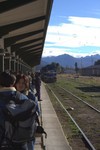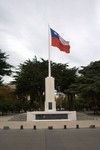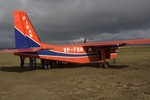I´m in Viedma, a pleasant and untouristy town on the banks of the Rio Negro, close to the Atlantic Coast. Why? Well, the train buff in me couldn´t let this trip pass by without a train ride, and one of the longest ones still running is from Bariloche to Viedma. Argentina once had a very comprehensive rail network (mostly built in the Edwardian period) but that was comprehensively destroyed by privatisation in the early ´90s (sounds familiar!)
Anyway, I´m on my way to Buenos Aires, so rather than do another 30+ hour bus ride, I reckoned I´d do a 15 hour train ride and then a 12 hour bus ride instead. If you look at the handy map of surviving rail services, you´ll see that I could in theory have taken a train all the way to BA – after all, Paul Theoroux did in The Old Patagonian Express. That was in 1978 – nowadays the service from Bariloche to Viedma is run by Tren Patagonico, which is owned by the regional government of Rio Negro province. The service to Buenos Aires leaves from Viedma´s older sister town of Carmen de Patagones, which is on the north side of the river and consequently in a different region and run by a different company. They don´t connect, so I had a choice of spending three days in Viedma and Patagones or taking the bus. I´m taking the bus.
Anyway, my journey began badly on Wednesday afternoon when I went to Bariloche station to buy a ticket. I´d intended to buy a ticket for “Cama” (sleeper) class, but it was sold out, so I bought a ticket for “Pullman” class instead. This was nearly half the price, so I wasn´t sure what I was letting myself in for! My hosts in the hostel, Carlos, Juan and Veronica, reckon I´m loco (mad!) not to be taking the bus instead…

Waiting for the train…
Anyway, come Sunday afternoon I packed up my bongos and dragged all my baggage down to the station on the bus. The train might be slow and only twice a week but it´s very cheap and there were a lot of people on the platform. When it came in I found my seat in the Pullman coach, which was not quite what I was expecting. George Pullman would probably have objected somewhat to his name being affixed to a coach full of elderly metal seats with wipe-clean blue vinyl covers, but the seats were fairly comfortable and there was loads of legroom.

Inside the “Pullman” coach
The train leaves Bariloche behind quite rapidly and leads into a Wild West landscape of vast expanses of scrubby Patagonian grassland puntcuated by dramatic craggy rock formations scoured into Barbara Hepworth-esque shapes by the wind. We pass through a couple of stations that serve minute settlements – no-one´s booked to use them so the train won´t stop. Soon it goes dark and I stop looking out of the window. A steward, who could be Jools Holland´s long-lost Latino brother, appears and takes for reservations for dinner in the restaurant car. I agree, and then get the main dishes summarised at high speed in Spanish, out of which linguistic maelstrom I pluck the words for “chicken” and “salad”. He seems satisfied with my choice and beetles off, warning me that he might have to seat me with strangers if the restaurant is busy.

Patagonian sheep running away from the train at sunset
Come nine o´clock, four hours out of Bariloche, and dinner is served. The restaurant car is easily the best feature of the train – it´s nicely decorated in the company colours of blue and yellow, with loose wooden chairs just like a proper restaurant. Jools Holland brings me two young chaps to have dinner with – we converse in extremely bad Spanish, very hestitantly, as they speak fast and quietly and I can´t make out what they´re saying over the noise of the train. It turns out they´ve been to Bariloche to buy a second-hand car (they´re both mechanics) and are bringing it back on the train – which has a flat wagon at the back for just this purpose.
We have a starter of cold meats and salad, followed by chicken (me) or ravioli (them) and then “flan”, which is Argentine Spanish for Creme Caramel. Not bad at all for 20 pesos (7 quid) all in.
Whilst we´re eating the train pulls in to the station at Ingeniero Jacobacci, one of the largest on the route and named after the guy who built the line.
This is where La Trochita, the 400km narrow-gauge line to Esquel which Theroux made famous, joins the main network. I can just about make out the line snaking off into the darkness. Sadly, the Trochita rarely comes all the way to Jacobacci these days – only on special charters for railfans.
After dinner, I head back to Pullman (declining my free ticket to see the film “Doom” in the Cine-Coach – another great idea British trains should bring back) and nod off as best I can. Inevitably the train makes two or perhaps three stops overnight, culminating in a long one at San Antonio Oeste at about 0530, where the train reverses.
At 8am we rejoin Jools for breakfast of coffee, toast and a “medialuna” – an Argentinian croissant, very very sweet indeed and then watch the totally flat landscape slip away at the leisurely pace of no more than 50 mph. The line is virtually worn out and the train bounces and rattles over the track, so I´m grateful that we´re not setting any speed records. We arrive in Viedma at 1000, almost an hour earlier than planned. I get a taxi (no obvious buses, of course) to the bus terminal and leave my backpack with the man in the Andesmar bus company office, then walk into town. I completely fail to find the tourist information office and blunder into the commercial district. I sit down briefly in the plaza outside the cathedral to check in the guidebook – and am rapidly deprived of one peso in small change by a scruffy guy with a sign saying he needs new glasses (which is probably believable with the way he´s squinting) and then of five pesos by a formidable lady with two exceptionally dirty and barefoot children, who demands that she needs to buy milk. Not wishing to further remunerate all the vagrants of the city of Viedma, I go back to the riverbank and sit in the sunshine near the ferry terminal, which appears almost entirely devoid of people. I noodle about, watching the canoeists on the river and eventually come across the tourist information centre. The lady is extremely helpful (I´m probably the only person she´s seen all day) and gives me a big wodge of maps and brochures showing where all the sights of both cities are. Looking at the timetable she´s given me I can go to the Historical Museum in Patagones that afternoon between 2:30 and 4:30, then go around to the Coastguard museum at 5, then come back to Viedma on the ferry to see the fascinating sounding Technological Museum of Water and Soil at 6 o´clock. So I had lunch – in a place which contained both a restaurant and a cafe, and got accidentally steered into the restauranty bit by the waiter where I ate ravioli whilst surrounded by smart lunchers in suits – and then took the very jolly little ferry across the Rio Negro to Carmen de Patagones. Despite the fact that the two towns are linked by two road bridges (one of which also carries the railway) there´s a ferry linking the two town centres as it saves you walking almost a mile.
The historical museum is fascinating – in a lovely Spanish-style house which was once the Bank of Patagonia – and the genial curator shows me around and agrees to speak slow Spanish for my benefit. At the back is a cave dwelling, built by the original settlers who were destitute peasants sent here from Spain in the 1790s. The town of Carmen de Patagones was later a port, and succeeded because it´s authorities chose to negotiate and act reasonably towards the native peoples of the region. It collapsed as a mercantile centre once a deep water port opened at San Antonio, on the Atlantic coast. The museum has a fine selection of artefacts from the town´s heyday.
After finding an icecream, I strolled down to the Coastguard building, and as I was early I watched about 8 guys attempt to manoeuvre their boat onto a trailer on a slipway. At first it wasn´t obvious, as the trailer was totally submerged and marked only with bamboo canes, but with a lot of goodnatured shouting and pulling on ropes by coastguards in rather unflattering orange drysuits, they got it in position. Then I asked the guy in charge where the museum was, whereupon he told me it was closed today. So I tootled back towards the ferry, looked into the cathedral (very neoclassical) and then headed to the Technological Museum, which turned out also to be just closing rather than just opening (nil points to City of Viedma Tourist Disinformation!) , but the very enthusiastic lady showed me around their interactive exhibits on water supply and cultivation in the region – lots of cool scale models of hydroelectric schemes and that kind of thing.
Now I´m in a cybercafe killing time until a) it´s a reasonable time to eat again and b) I can go to the bus terminal and wait for my bus, which leaves at 03:00 (thank you, Andesmar buses!). Tomorrow is another day, and Buenos Aires, and my amigo Alejandro, ex-doctor of San Martin base. Hasta mañana!
More photos of the train journey, Viedma and Carmen de Patagones






